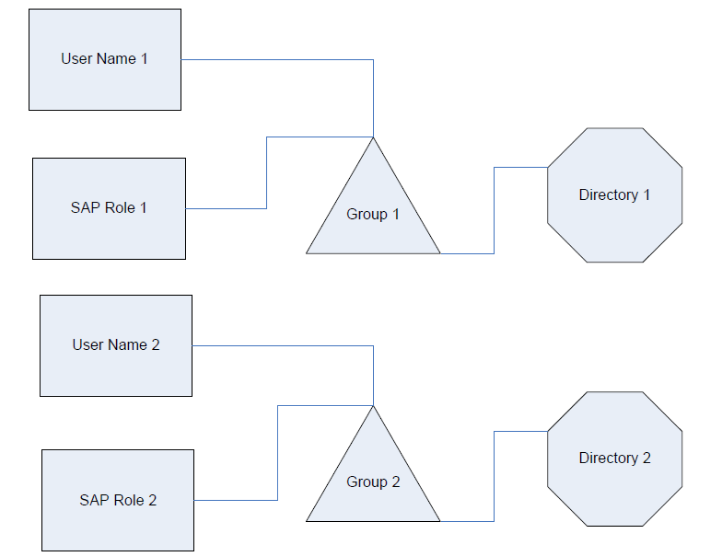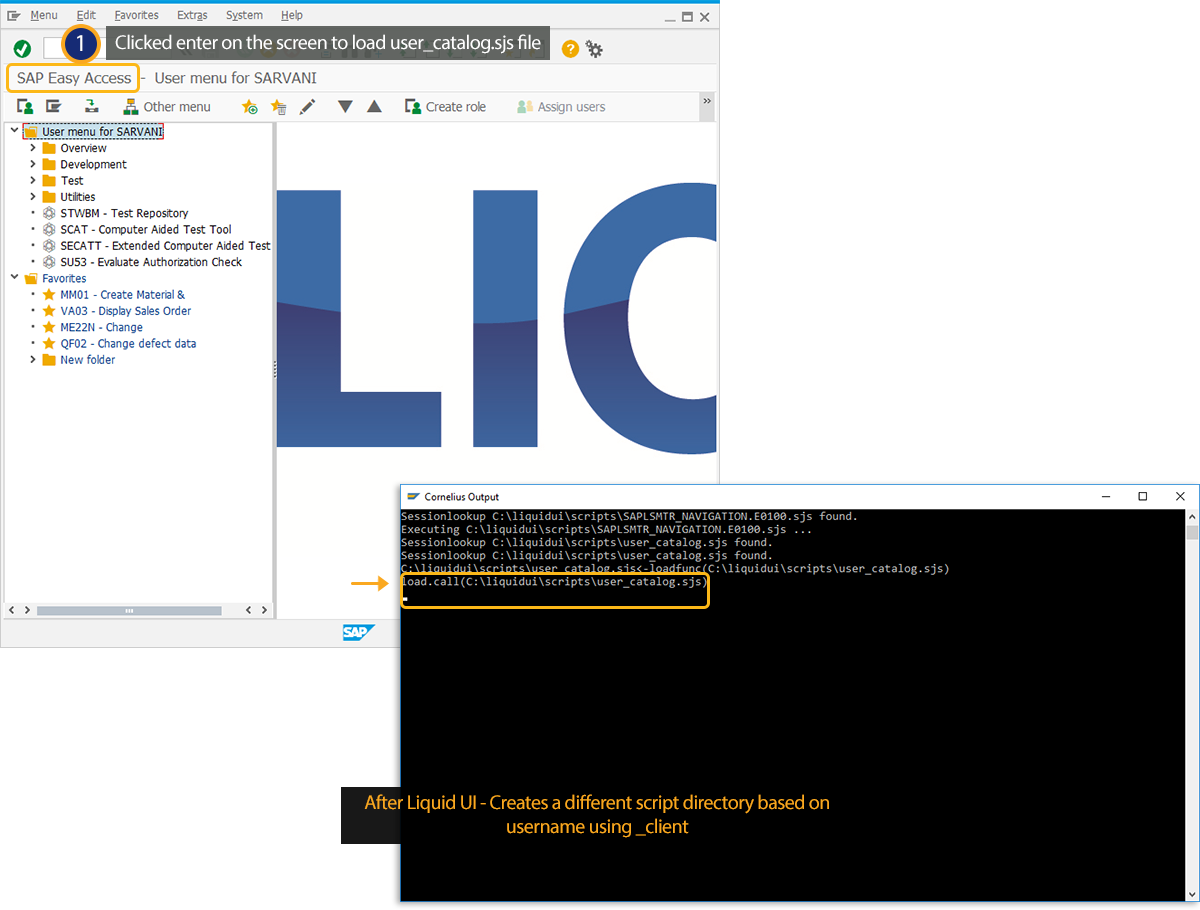Prerequisites
- Products: Liquid UI WS, Liquid UI Server or Local DLL, Client Software
- Commands: enter(), call(), load()
- Function Module: BAPI_USER_GET_DETAIL
Purpose
Learn how to get the username and role of the current user using the _client command. Here, we have loaded the User Catalog file into the directory folder to create and assign a script directory for each group of users logged into the SAP to assign/change Directory 1 of the scripts based on the group assignment for an SAP User/Role.


User Interface
//Create the files USER_CATALOG.sjs and SAPLSMTR_NAVIGATION.E0100.sjs inside your script folder for customizing the SAP Easy Access screen
//Now, let's start adding the Liquid UI script to these files and save them.
- Logon to SAP. On the appeared SAP Easy Access screen, you can assign a script directory for each group of users logged into the SAP. Add the following Liquid UI code to the USER_CATALOG.sjs and SAPLSMTR_NAVIGATION.E0100.sjs files.
//USER_CATALOG.sjs
User Group Corresponding to Directory1
var GROUP_CATALOG_ARRAY = [
{
"groupname":"G1",
"d1":"c:\\guixt\\G1\\d1",
"tcode":"/nsmen"
},
{
"groupname":"G2",
"d1":"SAPWR:Z.GUIXT",
"tcode":"/nva01"
},
{
"groupname":"G3",
"d1":"\\\\guixt.com\\usr\\SYNACTIVE\\Accounts\\Sempra\\M&I Group\\Consulting\\Scripts\\LC-FOS-DOC_scripts",
"tcode":"/nva01"
}
];
**/
var GROUP_CATALOG_ARRAY = [
{
"groupname":"G1",
"d1":"c:\\guixt\\G1\\d1",
"tcode":"/nsmen"
},
{
"groupname":"G2",
"d1":"\\\\guixt.com\\usr\\SYNACTIVE\\Accounts\\Sempra\\M&I Group\\Consulting\\Scripts\\LC-FOS-DOC_scripts",
"tcode":"/nva01"
}
];
/**
User assignment to *one* group
var USER_CATALOG_ARRAY = [
{
"user":"800/umang",
"group":"G1"
},
{
"user":"800/zac",
"group":"G1"
},
{
"user":"800/rumi",
"group":"G2"
}
];
**/
var USER_CATALOG_ARRAY = [
{
"user":"800/umang",
"group":"G1"
},
{
"user":"800/zlee",
"group":"G3"
},
];
/**
SAP Role assignment to *one* group
var ROLE_CATALOG_ARRAY = [
{
"role":["Z_GUIXTNEW"],
"group":"G1"
},
{
"role":["ZGUIXTROLE2"],
"group":"G1"
}
];
**/
var ROLE_CATALOG_ARRAY = [
{
"role":["Z_GUIXTNEW","Z_GUIXTRFC4"],
"group":"G1"
}
];
/**
Load User Catalog Call Function
**/
//Function to load the user catalog
function load_user_catalog(group_array,user_array,role_array) {
var current_client_user = _client + '/' + _user.toLowerCase().replace(/^\s+|\s+$/g,"");
if(user_array && user_array.length > 0) {
for(i = 0; i<user_array.length; i++) {
if(user_array[i].user == current_client_user) {
for(j = 0; j<group_array.length; j++) {
if(user_array[i].group == group_array[j].groupname) {
if(group_array[j].d1) {
enter(group_array[j].tcode +"/d1=" + group_array[j].d1);
break;
}
}
}
break;
}
}
}
if(role_array && role_array.length > 0) {
var Z_ROLES = [];
call('BAPI_USER_GET_DETAIL', {"in.USERNAME":"&V[_user]","table.ACTIVITYGROUPS":"Z_ROLES"});
for(i = 0; i<role_array.length; i++) {
var role_match_count = 0;
for(m = 0; m <role_array[i].role.length; m++) {
for (j = 0; j < Z_ROLES.length; j++) {
var z_userrole = Z_ROLES[j].toString().substring(0,30);
if(role_array[i].role[m].toLowerCase().replace(/^\s+|\s+$/g,"") == z_userrole.toLowerCase().replace(/^\s+|\s+$/g,"")) {
role_match_count++;
}
}
}
if(role_match_count == role_array[i].role.length) {
for(k = 0; k<group_array.length; k++) {
if(role_array[i].group == group_array[k].groupname) {
if(group_array[k].d1) {
enter(group_array[k].tcode +"/d1=" + group_array[k].d1);
break;
}
}
}
break;
}
}
}
}
//Call function once
if(!load_user_catalog_flag) {
load_user_catalog_flag = 'X';
load_user_catalog(GROUP_CATALOG_ARRAY,USER_CATALOG_ARRAY,ROLE_CATALOG_ARRAY);
} - Use load command to add the user_catalog.sjs.
//SAPLSMTR_NAVIGATION.E0100
// Calls the user_catalog.sjs file to customize the SAP screen.
load('user_catalog.sjs');SAP Process
- Refresh the SAP Easy Access screen, and click enter to load the User Catalog file. This will create and assign a script directory for each group of users logged into SAP, as shown in the image below.

- Refresh the SAP Easy Access screen, and click enter to load the User Catalog file. This will create and assign a script directory for each group of users logged into SAP, as shown in the image below.




